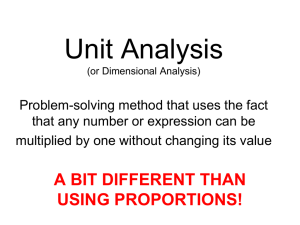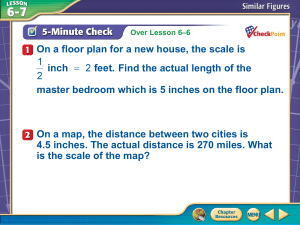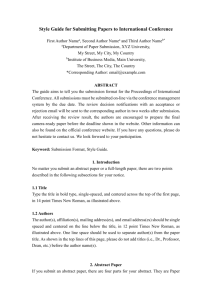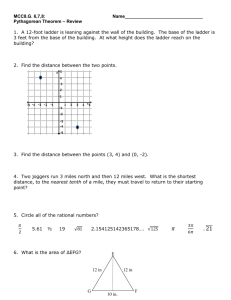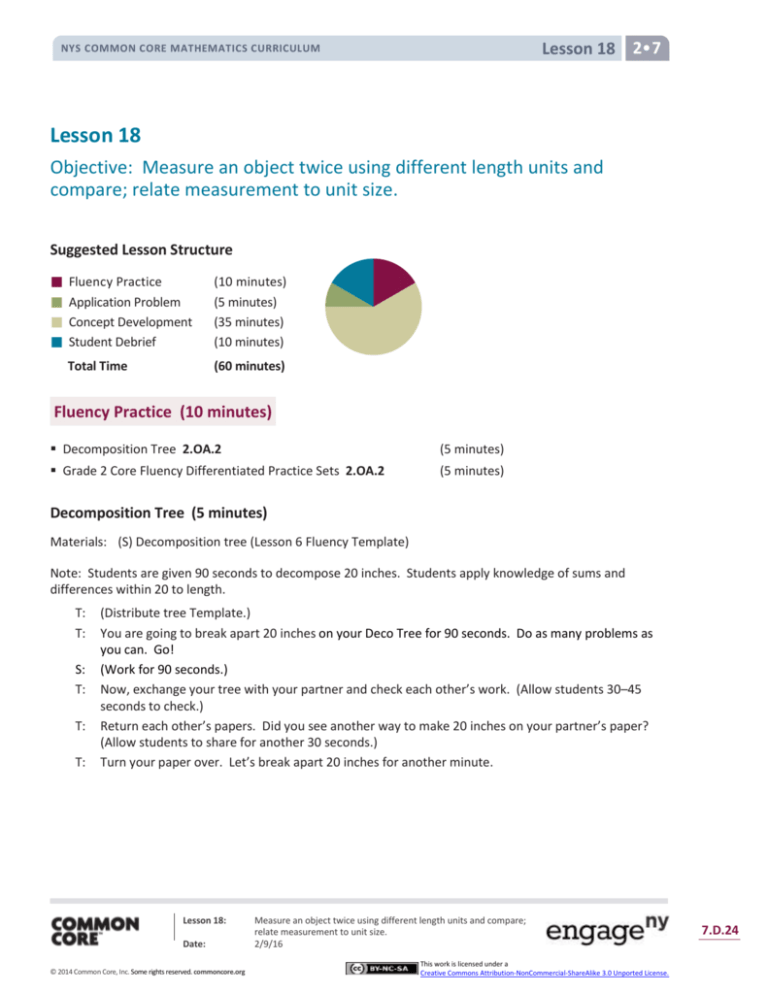
Lesson 18 2•7
NYS COMMON CORE MATHEMATICS CURRICULUM
Lesson 18
Objective: Measure an object twice using different length units and
compare; relate measurement to unit size.
Suggested Lesson Structure
Fluency Practice
Application Problem
Concept Development
Student Debrief
Total Time
(10 minutes)
(5 minutes)
(35 minutes)
(10 minutes)
(60 minutes)
Fluency Practice (10 minutes)
Decomposition Tree 2.OA.2
(5 minutes)
Grade 2 Core Fluency Differentiated Practice Sets 2.OA.2
(5 minutes)
Decomposition Tree (5 minutes)
Materials: (S) Decomposition tree (Lesson 6 Fluency Template)
Note: Students are given 90 seconds to decompose 20 inches. Students apply knowledge of sums and
differences within 20 to length.
T:
T:
S:
T:
T:
T:
(Distribute tree Template.)
You are going to break apart 20 inches on your Deco Tree for 90 seconds. Do as many problems as
you can. Go!
(Work for 90 seconds.)
Now, exchange your tree with your partner and check each other’s work. (Allow students 30–45
seconds to check.)
Return each other’s papers. Did you see another way to make 20 inches on your partner’s paper?
(Allow students to share for another 30 seconds.)
Turn your paper over. Let’s break apart 20 inches for another minute.
Lesson 18:
Date:
© 2014 Common Core, Inc. Some rights reserved. commoncore.org
Measure an object twice using different length units and compare;
relate measurement to unit size.
2/9/16
This work is licensed under a
Creative Commons Attribution-NonCommercial-ShareAlike 3.0 Unported License.
7.D.24
Lesson 18 2•7
NYS COMMON CORE MATHEMATICS CURRICULUM
Grade 2 Core Fluency Differentiated Practice Sets (5 minutes)
Materials: (S) Core Fluency Practice Sets (Lesson 1 Core Fluency Practice Sets)
Note: During Topic D and for the remainder of the year, each day’s Fluency Practice includes an opportunity
for review and mastery of the sums and differences with totals through 20 by means of the Core Fluency
Practice Sets or Sprints. The process is detailed and Practice Sets are provided in Lesson 1.
Application Problem (5 minutes)
Ezra is measuring things in his bedroom. He thinks his bed is
about 2 yards long. Is this a reasonable estimate? Explain
your answer using pictures, words, or numbers.
Note: This Application Problem provides practice using
benchmarks to estimate measurement. When students
finish, invite them to share their reasoning with either the
whole group or with partners.
Concept Development (35 minutes)
Materials: (T) Chart for recording measurements as pictured below (S) Centimeter ruler, inch ruler, 1 plain
sheet of white paper, bag with an unsharpened pencil, a new crayon, a new eraser
Part 1: Compare centimeters and inches.
Assign Partners A and B.
T:
T:
S:
T:
S:
T:
MP.2
S:
T:
S:
T:
Partner A, measure the pencil using the inch ruler. Partner B,
measure the pencil using the centimeter ruler.
Partner A, how long is the pencil?
About 7 inches!
(Record answer.) Partner B, how long is the pencil?
About 18 centimeters!
(Record answer.) Hmm, why do you think the
measurements are so different? Turn and talk.
We used different units to measure. He measured
with an inch ruler, and I used a centimeter ruler.
Are both measurements correct?
Yes!
Let’s check and see. Partner A, this time measure the
pencil with the centimeter ruler. Partner B, measure
the pencil with the inch ruler.
Lesson 18:
Date:
© 2014 Common Core, Inc. Some rights reserved. commoncore.org
NOTES ON
MULTIPLE MEANS
OF ACTION AND
EXPRESSION:
Scaffold the lesson for English language
learners by pointing to the inch ruler
and the centimeter ruler while giving
directions. Point out the different
units on the rulers while asking
students which unit is bigger, the inch
or the centimeter.
Measure an object twice using different length units and compare;
relate measurement to unit size.
2/9/16
This work is licensed under a
Creative Commons Attribution-NonCommercial-ShareAlike 3.0 Unported License.
7.D.25
Lesson 18 2•7
NYS COMMON CORE MATHEMATICS CURRICULUM
MP.2
S:
T:
S:
T:
S:
T:
S:
T:
S:
T:
S:
(Measure.)
Are your measurements the same as your partner’s when using the different rulers?
Yes!
Which is longer, a unit of one centimeter or one inch?
An inch!
That means 7 inches is about the same length as 18 centimeters. Did we use more centimeters or
more inches to measure the pencil?
More centimeters.
Why did we need more centimeters to measure the pencil?
Centimeters are smaller, so it takes more of them to cover the length of the pencil.
Talk to your partner about why the measurements are different for the same object.
Centimeters are smaller than inches. It takes fewer inches to measure because inches are bigger.
The smaller the unit, the more units it takes to measure the same thing.
Part 2: Measure using centimeters and inches.
Give students time to measure the objects in their bags and the sides of the white paper using both inches
and centimeters. They should stop to record the measurements on the plain paper as they go. Encourage
students to replicate the chart above to organize their work.
T:
S:
T:
S:
T:
S:
T:
T:
S:
T:
S:
T:
T:
What pattern do you see in your measurements using the different rulers?
The number of inches is always smaller. The number of centimeters is always bigger because a
centimeter unit is smaller than an inch unit, and it takes more of them when we are measuring.
Does this remind you of the time we measured straws with two different-size paper clips?
Yes!
Turn and talk: What do you know about measurement
and unit size?
NOTES ON
The smaller the unit means it takes more of those units
MULTIPLE MEANS
when measuring something. The bigger the unit
OF ENGAGEMENT:
means you use less of them.
Support students performing below
grade level by repeating the activity
Using your rulers, draw two lines on your white paper.
with different lengths. Ask them to
Make one line 5 inches and the other 5 centimeters.
draw lines that are 6 centimeters long
Before you begin, tell your partner which line will be
and 6 inches long. Repeat until
longer.
students are sure that the inch line is
The 5-inch line!
longer than the centimeter line and
can explain the following:
Tell your partner how you know.
The same number of units will
One inch is longer than 1 centimeter, so 5 inches will
make a longer line when using
be longer than 5 centimeters. Inches are longer, so
inches rather than centimeters.
the line will be longer too.
It takes more centimeters than
(Allow students time to draw the two lines.)
inches to measure different
Were we right? Is the 5-inch line longer than the
objects.
5-centimeter line?
Lesson 18:
Date:
© 2014 Common Core, Inc. Some rights reserved. commoncore.org
Measure an object twice using different length units and compare;
relate measurement to unit size.
2/9/16
This work is licensed under a
Creative Commons Attribution-NonCommercial-ShareAlike 3.0 Unported License.
7.D.26
Lesson 18 2•7
NYS COMMON CORE MATHEMATICS CURRICULUM
S:
T:
S:
T:
S:
T:
S:
Yes!
Look at your lines. How many centimeters do
you think it would take to equal 5 inches? Use
your centimeter ruler to check your estimate.
(Allow students time to check their estimate.)
Thirteen centimeters is about 5 inches.
Measure to see about how many inches
5 centimeters is.
About 2 inches!
How many centimeters would it take to be longer
than 5 inches? Would you have to measure
again, or could you figure it out another way?
We wouldn’t have to measure again because we
know that 13 centimeters is about 5 inches, so to
be longer than 5 inches, it can be any number of
centimeters more than 13.
Problem Set (10 minutes)
Students should do their personal best to complete the
Problem Set within the allotted 10 minutes. For some
classes, it may be appropriate to modify the assignment by
specifying which problems they work on first. Some
problems do not specify a method for solving. Students
should solve these problems using the RDW approach used
for Application Problems.
Student Debrief (10 minutes)
Lesson Objective: Measure an object twice using different
length units and compare; relate measurement to unit
size.
The Student Debrief is intended to invite reflection and
active processing of the total lesson experience.
Invite students to review their solutions for the Problem
Set. They should check work by comparing answers with a
partner before going over answers as a class. Look for
misconceptions or misunderstandings that can be
addressed in the Debrief. Guide students in a conversation
to debrief the Problem Set and process the lesson.
Lesson 18:
Date:
© 2014 Common Core, Inc. Some rights reserved. commoncore.org
Measure an object twice using different length units and compare;
relate measurement to unit size.
2/9/16
This work is licensed under a
Creative Commons Attribution-NonCommercial-ShareAlike 3.0 Unported License.
7.D.27
Lesson 18 2•7
NYS COMMON CORE MATHEMATICS CURRICULUM
Any combination of the questions below may be used to lead the discussion.
Look at the lines you measured on your Problem Set. Talk to your partner about why it is important
to label the length with your chosen unit. Why is it important to label our numbers in math in
general?
Look at Problem 5 on your Problem Set. Are the lines you drew equal in length? Why might
somebody think that the lines should be equal?
Can you think of other times when we have used different units in math?
When you measured in centimeters and inches, what did you do when your measurement wasn't
exact? What language do we use to describe measurements that are not exact?
Talk to your partner about why the unit size matters when we are measuring things.
Why do we measure using different units? When would you want to measure using a small unit?
A large unit?
Exit Ticket (3 minutes)
After the Student Debrief, instruct students to complete the Exit Ticket. A review of their work will help with
assessing students’ understanding of the concepts that were presented in today’s lesson and planning more
effectively for future lessons. The questions may be read aloud to the students.
Lesson 18:
Date:
© 2014 Common Core, Inc. Some rights reserved. commoncore.org
Measure an object twice using different length units and compare;
relate measurement to unit size.
2/9/16
This work is licensed under a
Creative Commons Attribution-NonCommercial-ShareAlike 3.0 Unported License.
7.D.28
Lesson 18 Problem Set 2•7
NYS COMMON CORE MATHEMATICS CURRICULUM
Name
Date
Measure the lines in inches and centimeters. Round the measurements to the nearest
inch or centimeter.
1.
______ cm
______ in
______ cm
______ in
______ cm
______ in
______ cm
______ in
2.
3.
4.
5. a. Did you use more inches or more centimeters when measuring the lines above?
_______________________________
b. Write a sentence to explain why you used more of that unit.
____________________________________________________________
____________________________________________________________
Lesson 18:
Date:
© 2014 Common Core, Inc. Some rights reserved. commoncore.org
Measure an object twice using different length units and compare;
relate measurement to unit size.
2/9/16
This work is licensed under a
Creative Commons Attribution-NonCommercial-ShareAlike 3.0 Unported License.
7.D.29
NYS COMMON CORE MATHEMATICS CURRICULUM
Lesson 18 Problem Set 2•7
6. Draw lines with the measurements below.
a. 3 centimeters long
b. 3 inches long
7. Thomas and Chris both measured the crayon below but came up with different
answers. Explain why both answers are correct.
Thomas:
8
cm
Chris:
3
in
Explanation: ___________________________________________________
____________________________________________________________
____________________________________________________________
____________________________________________________________
Lesson 18:
Date:
© 2014 Common Core, Inc. Some rights reserved. commoncore.org
Measure an object twice using different length units and compare;
relate measurement to unit size.
2/9/16
This work is licensed under a
Creative Commons Attribution-NonCommercial-ShareAlike 3.0 Unported License.
7.D.30
Lesson 18 Exit Ticket 2•7
NYS COMMON CORE MATHEMATICS CURRICULUM
Name
Date
Measure the lines in inches and centimeters.
1.
______ cm
______ in
______ cm
______ in
2.
Lesson 18:
Date:
© 2014 Common Core, Inc. Some rights reserved. commoncore.org
Measure an object twice using different length units and compare;
relate measurement to unit size.
2/9/16
This work is licensed under a
Creative Commons Attribution-NonCommercial-ShareAlike 3.0 Unported License.
7.D.31
Lesson 18 Homework 2•7
NYS COMMON CORE MATHEMATICS CURRICULUM
Name
Date
Measure the lines in inches and centimeters. Round the measurements to the nearest
inch or centimeter.
1.
______ cm
______ in
______ cm
______ in
______ cm
______ in
______ cm
______ in
2.
3.
4.
Lesson 18:
Date:
© 2014 Common Core, Inc. Some rights reserved. commoncore.org
Measure an object twice using different length units and compare;
relate measurement to unit size.
2/9/16
This work is licensed under a
Creative Commons Attribution-NonCommercial-ShareAlike 3.0 Unported License.
7.D.32
NYS COMMON CORE MATHEMATICS CURRICULUM
Lesson 18 Homework 2•7
5. a. Draw a line that is 5 centimeters in length.
b. Draw a line that is 5 inches in length.
6. a. Draw a line that is 7 inches in length.
b. Draw a line that is 7 centimeters in length.
7. Takeesha drew a line 9 centimeters long. Damani drew a line 4 inches long.
Takeesha says her line is longer than Damani’s because 9 is greater than 4. Explain
why Takeesha might be wrong.
_______________________________________________________________
_______________________________________________________________
_______________________________________________________________
8. Draw a line that is 9 centimeters long and a line that is 4 inches long to prove that
Takeesha is wrong.
Lesson 18:
Date:
© 2014 Common Core, Inc. Some rights reserved. commoncore.org
Measure an object twice using different length units and compare;
relate measurement to unit size.
2/9/16
This work is licensed under a
Creative Commons Attribution-NonCommercial-ShareAlike 3.0 Unported License.
7.D.33


